
The Mackensen class was the last class of battlecruisers to be built by Germany in World War I. The design initially called for seven ships, but three of them were redesigned as the Ersatz Yorck class. Of the four ships of the Mackensen class, Mackensen, Graf Spee, and Prinz Eitel Friedrich were launched, and Fürst Bismarck was not—but none were completed, after wartime shipbuilding priorities were redirected towards U-boats—and the ships were broken up in the early 1920s. The lead ship of the class was named for August von Mackensen, a prominent military commander during the war. In response to the Mackensen-class ships, the British Royal Navy laid down the Admiral-class battlecruisers, all but one of which would eventually be cancelled; the sole survivor, HMS Hood, was completed after the end of the war.

SMS Siegfried was the lead ship of the six-member Siegfried class of coastal defense ships built for the German Imperial Navy. Her sister ships were Beowulf, Frithjof, Heimdall, Hildebrand, and Hagen. Siegfried was built by the Germaniawerft shipyard between 1888 and 1890, and was armed with a main battery of three 24-centimeter (9.4 in) guns. She served in the German fleet throughout the 1890s and was rebuilt in 1903 - 1904. She served in the VI Battle Squadron after the outbreak of World War I in August 1914, but saw no action. Siegfried was demobilized in 1915 and used as a barracks ship thereafter. She was ultimately broken up for scrap in 1920.

SMS Ägir was the second and final member of the Odin class of coastal defense ships built for the Imperial German Navy. She had one sister ship, Odin. Ägir was named for the norse god, and was built by the Kaiserliche Werft in Danzig between 1893 and 1896. She was armed with a main battery of three 24-centimeter (9.4 in) guns. She served in the German fleet throughout the 1890s and was rebuilt in 1901–1903. She served in the VI Battle Squadron after the outbreak of World War I in August 1914, but saw no action. Ägir was demobilized in 1915 and used as a tender thereafter. After the war, she was rebuilt as a merchant ship and served in this capacity until December 1929, when she was wrecked on the island of Gotland.
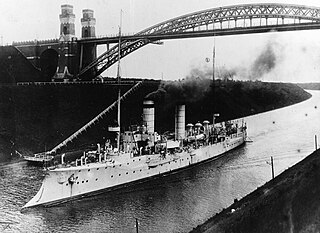
SMS Arcona was the ninth member of the ten-ship Gazelle class of light cruisers that were built for the German Kaiserliche Marine in the late 1890s and early 1900s. The Gazelle class was the culmination of earlier unprotected cruiser and aviso designs, combining the best aspects of both types in what became the progenitor of all future light cruisers of the Imperial fleet. Built to be able to serve with the main German fleet and as a colonial cruiser, she was armed with a battery of ten 10.5 cm (4.1 in) guns and a top speed of 21.5 knots. Arcona was a modified version of the basic Gazelle design, with improved armor and additional coal storage for a longer cruising range.
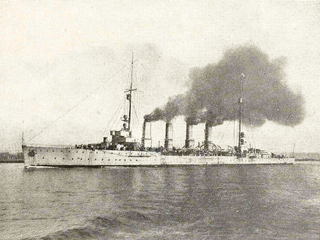
SMS Stralsund was a Magdeburg-class light cruiser of the German Kaiserliche Marine. Her class included three other ships: Magdeburg, Breslau, and Strassburg. She was built at the AG Weser shipyard in Bremen from 1910 to December 1912, when she was commissioned into the High Seas Fleet. The ship was armed with a main battery of twelve 10.5 cm SK L/45 guns and had a top speed of 27.5 knots.

The Brandenburg class consisted of four pre-dreadnought battleships built for the German Kaiserliche Marine, the first modern battleships of the fleet. The four ships of the class—Brandenburg, Wörth, Weissenburg, and Kurfürst Friedrich Wilhelm—were the first ocean-going capital ships built for the German fleet in nearly two decades, owing to reluctance in the Reichstag to fund large projects. They followed a series of small coastal defense ships, and though in retrospect they anticipated the buildup that created the High Seas Fleet, they were ordered as part of a construction program that reflected the strategic and tactical confusion that affected many navies in the 1880s. The design process that resulted in the Brandenburg class was very lengthy, with proposals that ranged from outdated casemate ships to versions with two twin-gun turrets placed side by side. The designers ultimately settled on ships that were armed with an unusual main battery of six 28 cm (11 in) guns at a time when all foreign battleships were built with four or fewer heavy guns.

The Braunschweig-class battleships were a group of five pre-dreadnought battleships of the German Kaiserliche Marine built in the early 1900s. They were the first class of battleships authorized under the Second Naval Law, a major naval expansion program. The class comprised five ships—Braunschweig, Elsass, Hessen, Preussen, and Lothringen—and they were an improvement over the preceding Wittelsbach class. The Braunschweigs mounted a more powerful armament of 28 cm (11 in) and 17 cm (6.7 in) guns. Less than two years after the first members of the class entered service, the ships were rendered obsolescent by the British all-big-gun battleship Dreadnought, which curtailed their careers.
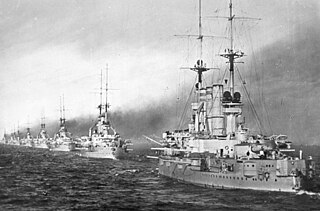
The Deutschland class was a group of five pre-dreadnought battleships built for the German Kaiserliche Marine, the last vessels of that type to be built in Germany. The class comprised Deutschland, the lead ship, Hannover, Pommern, Schlesien, and Schleswig-Holstein. The ships closely resembled those of the preceding Braunschweig class, but with stronger armor and a rearranged secondary battery. Built between 1903 and 1908, they were completed after the launch of the revolutionary British all-big-gun battleship HMS Dreadnought in 1906. As a result, they were obsolescent before entering service. The ships nevertheless saw extensive service in the High Seas Fleet, Germany's primary naval formation, through the late 1900s and early 1910s, when they were used for training, which included overseas cruises.

The Roon class was a pair of armored cruisers built for the German Kaiserliche Marine in the 1900s. The two ships of the class, Roon and Yorck, closely resembled the earlier Prinz Adalbert-class cruisers upon which they were based. The Roon class incorporated slight incremental improvements, including a pair of extra boilers. The ships were easily distinguished from their predecessors by the addition of a fourth funnel. Though the additional boilers were meant to increase the ships' speed, both vessels failed to reach their designed top speed. In addition, the ships had comparatively light armament and thin armor protection, so they compared poorly with their foreign contemporaries, particularly the armored cruisers of their primary opponent, the British Royal Navy.

The Odin class was a pair of coastal defense ships built for the German Kaiserliche Marine in the late 19th century. The class comprised two ships: Odin, named after the Norse god Odin, and Ägir, named after the Norse god of the same name. The ships were very similar to the preceding Siegfried-class coastal defense ships, and are sometimes considered to be one class of ships.

SMS Heimdall was the fourth vessel of the six-member Siegfried class of coastal defense ships built for the German Imperial Navy. Her sister ships were Siegfried, Beowulf, Frithjof, Hildebrand, and Hagen. Heimdall was built by the Kaiserliche Werft in Wilhelmshaven between 1891 and 1894, and was armed with a main battery of three 24-centimeter (9.4 in) guns. She served in the German fleet throughout the 1890s and was rebuilt in 1900–1902. She served in the VI Battle Squadron after the outbreak of World War I in August 1914, but saw no action. Heimdall was demobilized in 1915 and used as a barracks ship thereafter. She was ultimately broken up for scrap in 1921.

SMS Beowulf was the second vessel of the six-member Siegfried class of coastal defense ships built for the German Imperial Navy. Her sister ships were Siegfried, Frithjof, Heimdall, Hildebrand, and Hagen. Beowulf was built by the AG Weser shipyard between 1890 and 1892, and was armed with a main battery of three 24-centimeter (9.4 in) guns. She served in the German fleet throughout the 1890s and was rebuilt in 1900 – 1902. She served in the VI Battle Squadron after the outbreak of World War I in August 1914, but saw no action. Beowulf was demobilized in 1915 and used as a target ship for U-boats thereafter. She was ultimately broken up for scrap in 1921.
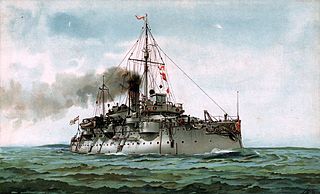
SMS Frithjof was the third vessel of the six-member Siegfried class of coastal defense ships built for the German Imperial Navy. Her sister ships were Siegfried, Beowulf, Heimdall, Hildebrand, and Hagen. Frithjof was built by the AG Weser shipyard between 1890 and 1893, and was armed with a main battery of three 24-centimeter (9.4 in) guns. She served in the German fleet throughout the 1890s and was rebuilt in 1900 - 1902. She served in the VI Battle Squadron after the outbreak of World War I in August 1914, but saw no action. Frithjof was demobilized in 1915 and used as a barracks ship thereafter. She was rebuilt as a merchant ship in 1923 and served in this capacity until she was broken up for scrap in 1930.

SMS Hildebrand was the fifth vessel of the six-member Siegfried class of coastal defense ships built for the German Imperial Navy. Her sister ships were Siegfried, Beowulf, Frithjof, Heimdall, and Hagen. Hildebrand was built by the Kaiserliche Werft at Kiel between 1890 and 1893, and was armed with a main battery of three 24-centimeter (9.4 in) guns. She served in the German fleet throughout the 1890s and was rebuilt in 1900–1902. She served in the VI Battle Squadron after the outbreak of World War I in August 1914, but saw no action. Hildebrand was demobilized in 1915 and used as a barracks ship thereafter. She ran aground while en route to the Netherlands for scrapping in 1919, and was eventually broken up in situ in 1933.
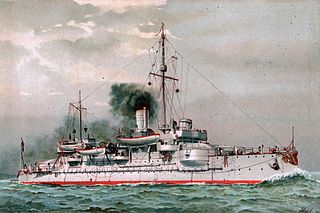
SMS Hagen was the final vessel of the six-member Siegfried class of coastal defense ships built for the German Imperial Navy. Her sister ships were Siegfried, Beowulf, Frithjof, Heimdall, and Hildebrand. Hagen was built by the Kaiserliche Werft in Kiel between 1891 and 1893, and was armed with a main battery of three 24-centimeter (9.4 in) guns. She served in the German fleet throughout the 1890s and was rebuilt in 1900 - 1902. She served in the VI Battle Squadron after the outbreak of World War I in August 1914, but saw no action. Hagen was demobilized in 1915 and used as a barracks ship thereafter. She was ultimately sold for scrap in 1919 and subsequently dismantled.

SMS Odin was the lead ship of her class of coastal defense ships built for the Imperial German Navy. She had one sister ship, Ägir. Odin, named for the eponymous Norse god, was built by the Kaiserliche Werft in Danzig between 1893 and 1896, and was armed with a main battery of three 24-centimeter (9.4 in) guns. She served in the German fleet throughout the 1890s and was rebuilt in 1901–1903. She served in the VI Battle Squadron after the outbreak of World War I in August 1914, but saw no action. Odin was demobilized in 1915 and used as a tender thereafter. After the war, she was rebuilt as a merchant ship and served in this capacity until 1935, when she was broken up for scrap.

The Irene class was a class of protected cruisers built by the Imperial German Navy in the late 1880s. The class comprised two ships, Irene and Prinzess Wilhelm; they were the first protected cruisers built by the German Navy. As built, the ships were armed with a main battery of fourteen 15 cm (5.9 in) guns and had a top speed of 18 knots. They were modernized in 1899–1905, and their armament was upgraded with new, quick-firing guns.

The Meteor class was a pair of two avisos built for the German Kaiserliche Marine in the late-1880s and early 1890s. The class comprised two ships: Meteor and Comet. Unlike earlier avisos built for the fleet, which were designed to fill a variety of roles, the Meteor class was intended to protect the fleet's capital ships from torpedo boat attacks. They were armed with a battery of four 8.8 cm (3.5 in) quick-firing guns. Both vessels suffered from serious problems that rendered them unfit for service, namely poor seakeeping and excessive vibration of their propeller shafts. As a result, they saw little service, with Comet's only periods in commission being to test what were unsuccessful attempts to correct the problems. Meteor had a somewhat more active career, serving with the fleet in 1893–1894 and then as a fishery protection ship in 1895–1896, but she, too, spent most of her existence laid up. Both vessels were decommissioned in 1896 and struck from the naval register in 1911. Meteor was then used as a barracks ship, while Comet became a storage hulk; the two ships were broken up in 1919 and 1921, respectively.
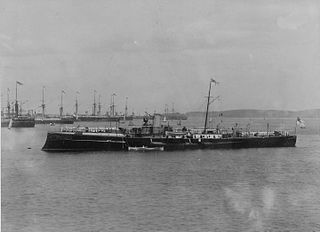
The Wacht class was a pair of avisos built by the German Kaiserliche Marine in the late-1880s; the class comprised two ships, Wacht and Jagd. They were laid down in 1886 and 1887 and completed by 1888 and 1889, respectively. The ships were based on the previous aviso, SMS Greif, which had proved to be an unsuccessful design due to its lack of torpedo armament. As a result, the Wacht-class ships were equipped with three torpedo tubes to improve their combat power; they were also the first German avisos to carry armor protection.

SMS Jagd was an aviso of the Imperial German Navy, the second and final member of the Wacht class. She had one sister ship, Wacht. Jagd was laid down in 1887 at the AG Weser shipyard, launched in July 1888, and commissioned in June 1889. She served in the German fleet for the next fifteen years, until she was withdrawn from active duty in 1904. Thereafter, she was used as a harbor ship. In 1910, she was stricken from the naval register and hulked. She was later used as a torpedo training platform until 1920, when she was sold for scrapping.

























